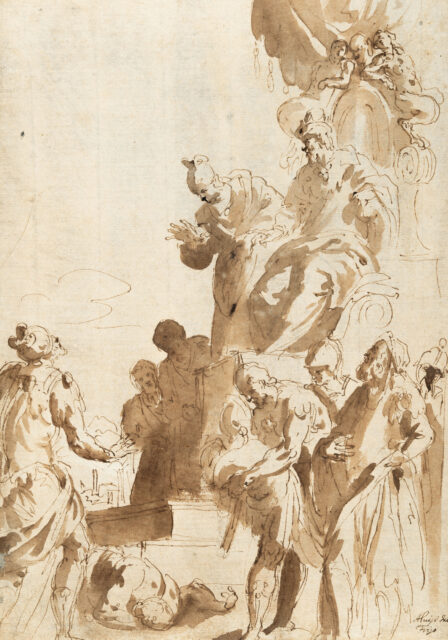Body of a naked warrior brought before a king
Details
Literatur:
Nicholas Turner, European master drawings from Portuguese collections, Lissabon 2000, S. 80, Kat.-Nr. 32, mit farb. Abb.;
William R. Rearick, Il disegno veneziano del Cinquecento, Mailand 2001, S. 132 und S. 222, Fußnote 197;
Dibujos de maestros europeos en las colecciones portuguesas, 1500–1800, hrsg. vom Museo Nacional del Prado, Madrid, 2002, Kat.-Nr. 19.
Ausstellung:
Desenhos de mestres europeus em colecções portuguesas, Centro cultural de Belém, Lissabon (Oktober–Dezember 2000), Kat.-Nr. 32
European Master Drawings from Portuguese Collections (1500 – 1800), Fitzwilliam Museum, Cambridge (16. Mai–13. August 2000), Kat.-Nr. 32
Desenhos de mestres europeus em colecções portuguesas, Museu Nacional Soares Dos Reis, Porto (Oktober–Dezember 2001), Kat.-Nr. 32
Dibujos de maestros europeus en las colecciones portuguesas (1500–1800), Museu Nacional del Prado, Madrid, 2002, Kat,-Nr. 19
Provenienz:
Zaccaria Sagredo (?), Venedig;
danach in Erbgang an die Nachkommen;
Jean-Jacques de Boissieu (?), Lyon;
Privatsammlung, Lugano;
Christie’s, London, Auktion, 7.7.1992, Los 146;
Europäische Privatsammlung.
Description
Besides his famous nickname “Alvise Benfatto Dal Friso”, the painter is also known as “Alvise de Paulo Veronese”. He was the son of a sister of Paolo Veronese and was trained in his uncle’s workshop. Alvise Dal Friso belongs to the so-called “Veronesiani”, the followers of Paolo Veronese, who orientated themselves on his painting technique and compositions. There is documentary evidence that he had his own workshop in Venice in 1584. Drawings by the artist are extraordinarily rare. Presumably, several of Alvise’s works are still hidden among those traditionally attributed to his uncle. This high-quality drawing bears Alvise’s name in brown ink in the lower right-hand corner in an 18th-century script, as does a sheet by the artist in the Albertina, Vienna (inv. no. 24037). This early attribution to Alvise Dal Friso was confirmed by Terence Mulally in 1992 on the occasion of the auction at Christie’s in London. In its strokes and brushwork with strong highlights and contrasts of light and dark, the sheet is reminiscent of Paolo Veronese’s drawings. The idiosyncratic figures with their elongated bodies, relatively small heads and the pronounced hand gestures are, however, new in the nephew’s work and quite characteristic of him. The subject has not yet been identified. The lifeless body of a naked man lying on the ground in the foreground appears to be that of a warrior, for one of the observers to his right is wearing a military uniform, including a breastplate. The dignitary seated on a high throne wears a turban crown and, according to Nicholas Turner, could be a Persian or Old Testament ruler. However, King David is to be excluded, as his son Absalom would not have been brought to him naked as a dead man. The very high throne, which has to be entered from behind as there are no visible steps at the front, is reminiscent of the pronounced diagonal axis in the “Allegory of Venice”, by Giovanni Battista Zelotti (c. 1526-1578) in the Palazzo Comunale in Parma. Both representations are so similar in terms of composition that it can be assumed that Alvise Dal Friso knew the work of Zelotti and was inspired by Zelotti’s composition when executing the drawing. William R. Rearick may have suggested Zelotti as the author of the drawing in a letter in 2001 for this reason, possibly as a preliminary study for the history painting in the salon of the Castello Porto Colleoni in Thiene, dated 1553, which shows Gaius Lucius Scaevola in front of the Etruscan ruler Porsenna. However, this attribution as well as the interpretation of the subject was not convincing, as it does not provide for the arrangement of a body lying on the ground, and also because of many other details in the drawing (see Nicholas Turner, in: Catalogue of the Museo del Prado, 2002, cat. no. 19). – Mounted in a laid paper collector’s mat along all edges. The edges of the sheet somewhat uneven. A few small losses at lower left, backed with grey laid paper. Minor stains. In good condition considering its age.
* All results incl. buyer’s premium (27%) without VAT. No guarantee, subject to error.
** All post-auction prices excl. buyer's premium and VAT. No guarantee, subject to error.
*** Conditional Sale: The bid was accepted below the limit. Acquisition of the work may still be possible in our post-auction sale.
R = regular taxation
N = differential taxation on works of art which originate from a country outside of the EU
The private or commercial use of images shown on this Website, in particular through duplication or dissemination, is not permitted. All rights reserved.


